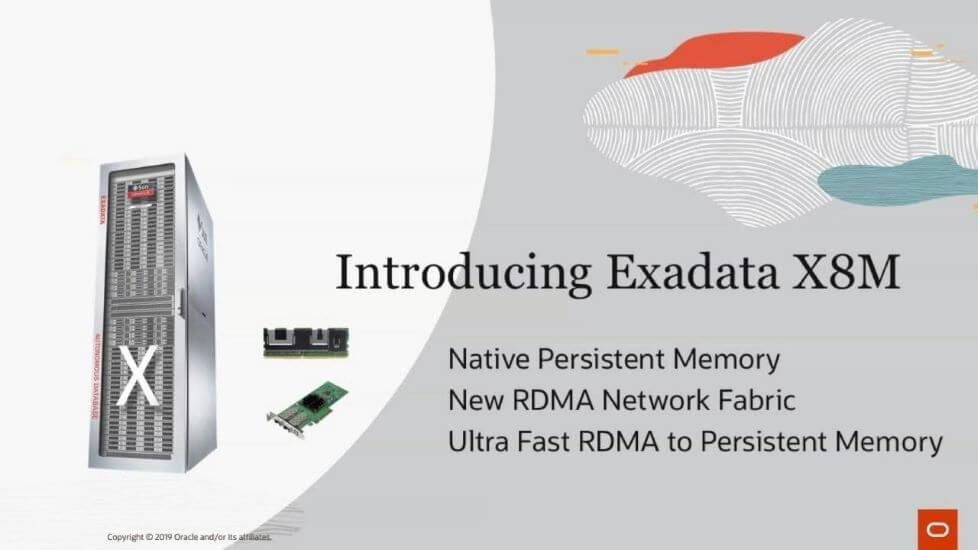
The News: Redwood Shores, Calif., October 8, 2020— Oracle today announced the new Oracle Exadata Cloud Service X8M on Oracle Cloud Infrastructure. Exadata X8M is available in 26 global cloud regions and Dedicated Region Cloud@Customer. Read the full release in the Oracle Newsroom.
Analyst Take: With today’s announcement, Oracle continues to aggressively improve and innovate on its Exadata Cloud Service and has made some important updates in its new X8M offering.
As I see it, the news provides material improvements and innovation into key areas that should provide a compelling use case for customers. The biggest changes in the newest generation of Oracle Exadata (X8M) includes the implementation of Intel Optane Persistent Memory, Petabyte Scale for storage volume, new elastic functionality giving customers greater flexibility and per the announcement, this will be offered at better pricing than the previous generation due to new more flexible configurations.
Exadata X8M Features Remote Direct Memory Access (RDMA) Powering Intel Optane Persistent Memory
During the pre-briefing, the use of RDMA to leverage Intel’s Optane Persistent Memory in smart storage servers immediately caught my attention. Using this Persistent Memory technology users are able to bypass the OS, IO, and network software stacks to yield higher transaction processing IOs, and a 10x improvement in latency from previous generations of Exadata Cloud.
For our more technically fluent readers, RDMA on this new service provides 100Gbs of throughput on an ultra-fast converged ethernet network fabric. This fabric is also known as RDMA over Converged Ethernet (RoCE).
One thing that Oracle was very consistent in pointing out is the advantage of its new X8M over relational databases using all-flash storage touting 50x improvements on speed. The greater speed and lower latency will certainly be well received by potential users in doing diligence for procuring database services of this scale.
Oracle Exadata Cloud Service X8M Can Scale to 25 PB
The newest generation of Exadata has broken through to meet the demand for greater storage capacity as well as improvements in its compute and networking. According to the release, the new Oracle Databases deployed on Exadata Cloud Service X8M can scale up to 4,600 CPU Cores, 44 TB DRAM, 96 TB Persistent Memory, 1.6 PB Flash, and 25 PB of database capacity.
These numbers are impressive as it puts Oracle in a position both competitively and to meet the needs of nearly every enterprise on the planet as there are very few customer requirement that could not be met by this service. Of course, volumes will continue to grow and I expect that Oracle’s future generations will address that from a storage, network and compute perspective.
Improved Elasticity for Greater Resource Control
One of the notable improvements with the Exadata Cloud Service X8M is that it is fully elastic. This is a material change from previous generations that had flexible resource consumption levels, but beyond the minimum requirements, this can be tuned with storage and compute resources on demand at the control of the user. Oracle’s announcement stated that “customers can start small with a minimum-sized HA configuration with as few as four CPU cores enabled, and expand by adding compute or storage as needed with no downtime.”
I like this as a bridge to full autonomous database services as many companies still seeking a level of control over resources, but also want to be able to quickly and reliably add or subtract resources to scale up/down.
Improved Cost Based on New Entry Points and Granular Pay-Per-Use
I believe the new scale and elasticity, on top of some very attractive new features including RDMA and Intel’s Optane Persistent Memory gives additional credence to Oracle’s Exadata Cloud Service X8M.
In the end, it comes down to usability and meeting enterprise needs as we move into a Petabyte scale world. This new offering from Oracle exhibits important capabilities that buyers should be looking for, which will enable them to run more databases, users, transactions, and analytics on less hardware. This, coupled with pay-per-use services that are marketed as “tracked by the second” allow customers to pay only for what they need–this should provide greater economies of scale for X8M users.
Overall, a solid set of improvements and innovation coming from Oracle with the launch of its next generation Exadata Cloud Service.
Futurum Research provides industry research and analysis. These columns are for educational purposes only and should not be considered in any way investment advice.
Read more analysis from Futurum Research:
Poly Announces Sync: Deepens Zoom Partnership at Zoomtopia 2020
Cloudera Acquires Eventador to Expand Stream Processing Capabilities
Image: Oracle
The original version of this article was first published on Futurum Research.
Daniel Newman is the Principal Analyst of Futurum Research and the CEO of Broadsuite Media Group. Living his life at the intersection of people and technology, Daniel works with the world’s largest technology brands exploring Digital Transformation and how it is influencing the enterprise. From Big Data to IoT to Cloud Computing, Newman makes the connections between business, people and tech that are required for companies to benefit most from their technology projects, which leads to his ideas regularly being cited in CIO.Com, CIO Review and hundreds of other sites across the world. A 5x Best Selling Author including his most recent “Building Dragons: Digital Transformation in the Experience Economy,” Daniel is also a Forbes, Entrepreneur and Huffington Post Contributor. MBA and Graduate Adjunct Professor, Daniel Newman is a Chicago Native and his speaking takes him around the world each year as he shares his vision of the role technology will play in our future.

